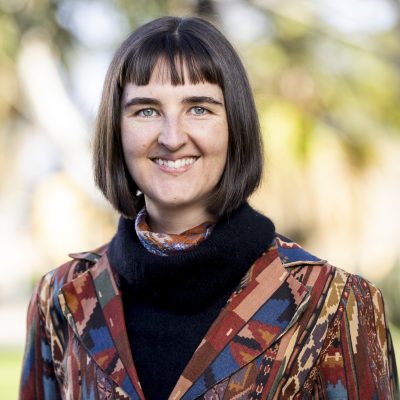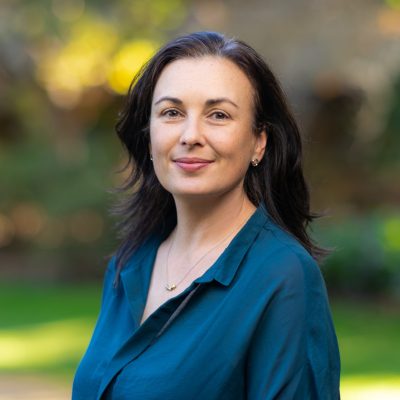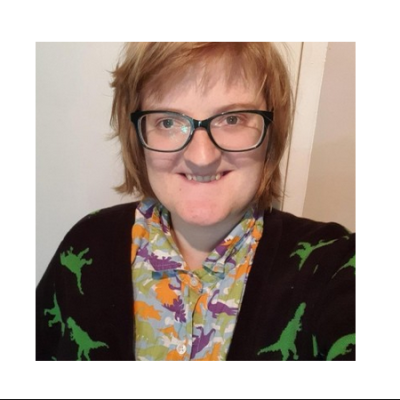Authentic Assessment
Linking up Student and Academic Voices: Reuniting Higher Education and the Public Sphere Through OER
La Trobe University
Dr Nikita Vanderbyl; Dr Katherine Ellinghaus; Dr Emma Robertson; Steven Chang; Clare O'Hanlon; and Nicole Gammie
Overview
This case study reflects on an open education practices (OEP) pilot project situated in a third-year history capstone course at La Trobe University: Making History: Communicating the Past (HIS3MHI). The project unites the voices of students and academics in showcasing Australian history for a general audience by using OER to publish multimodal student assessments. This generated a collection of historical writing that bridges the divide between the academic world and public history. We were inspired by projects implementing renewable assignments through student-generated OER (Fatayer & Tualaulelei, 2023).
An initial selection of student works were transformed into OER content, culminating in the first version of the open textbook Making Public Histories: Australian History Beyond the University (2023). We used an iterative publishing model to generate a second version combining chapters from professional historians (published 2024) with student work (published 2025) (See Table 1 for details).
| Version 1 | Version 2 |
|
|
We designed this “living textbook” to explore diverse digital mediums, uphold the high ethical standards expected of professional historians, and to recognise the importance of reflection for learning. The OER acts as a first step towards truly renewable assignments, as exemplified by the Motivation and Emotion text featuring 1500 student works published in Wikiversity (Neill, 2024). Our pilot project models important principles: these include reflective practices on the ethical dimensions of historical inquiry, collaborative methodologies, inclusive historical narratives, and engaging a broad audience.
Looking ahead, we outline how our project has unlocked possibilities for deepening integration between OER development and authentic assessment, forging partnerships with history associations and community heritage organisations, enhancing student employability, and strengthening student engagement. We conclude with recommendations for fellow open practitioners who want to create student-generated OER and living texts.
Using this case study
This chapter provides an overview of how renewable assignments can be openly published as a ‘living textbook’. After reading this chapter:
- Academic staff will: Develop awareness of the benefits and process for facilitating quality student authentic assessments to be published as an OER.
- Library staff will: Learn strategies and techniques for working with students and academics to publish high quality student created content.
Origins
In 2021, the Open Education Program of La Trobe eBureau (an in-house online publishing initiative) sought expressions of interest in trialling student-generated OER initiatives. Dr Nikita Vanderbyl, Lecturer in History, and Clare O’Hanlon, Senior Learning Librarian, shared an enthusiasm for open education and public history. This sparked the idea for an OER to be created in collaboration with students in Nikita’s third-year undergraduate subject, HIS3MHI, and to be published iteratively with subsequent cohorts. Students would be both co-creators and the intended users of the text.

Why OER?
This student-generated OER model complements the focus of HIS3MHI on preparing students for professional, ethical practice as historians. Students undertake a large independent research project on a topic of their choice and communicate their findings to a public audience using digital media, for example podcasts. Open pedagogy approaches were a natural fit for the subject’s focus on communicating to the public.
The work students generate for assessment often leads to the creation of sophisticated artefacts of Australian history. These are potentially valuable to public communities beyond the university, but largely remain “disposable assignments” unless converted into renewable ones in the form of OERs (Wiley and Hilton, 2018). Renewable assignments are student works that “won’t be discarded at the end of the process but will instead add value to the world in some way” (Wiley, 2016). This gives these works meaning beyond the university: in the words of one student co-author Thomas Amos, “it breathed new life into my assignment”.
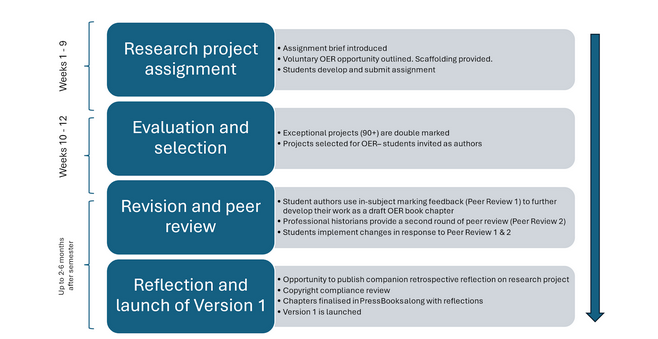
This OER project gave undergraduate students the opportunity to experience real-life publishing and engage in feedback literacies involved in responding to peer review. Diverse chapters were generated covering many themes within Australian history. This open content is relevant to several diverse audiences: future cohorts studying the subject, postgraduate history students, schoolteachers, the public, and professional historians.
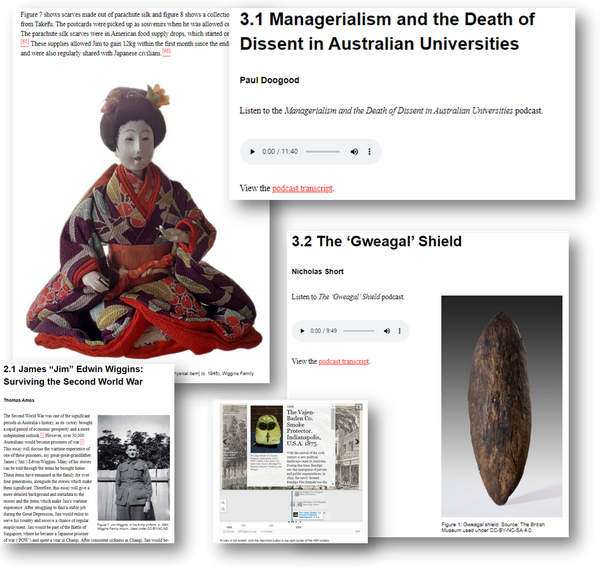
Forming a collaborative network beyond traditional boundaries
Our ongoing project-based collaboration shares features with the Third Space framework (Whitchurch, 2012) in modelling integrated ways of working that go beyond traditional university department boundaries.
We created a small academic-professional staff ecosystem (illustrated by Figure 4) of mutual learning processes, enabling students to engage with a variety of practitioners from inside the subject, adjacent to it, and beyond the university. The role of external practitioners as peer reviewers in our collaborative network represents a modest step towards the adapted OER development model articulated by Fatayer and Tualaulelei (2023) (illustrated by Figure 5).
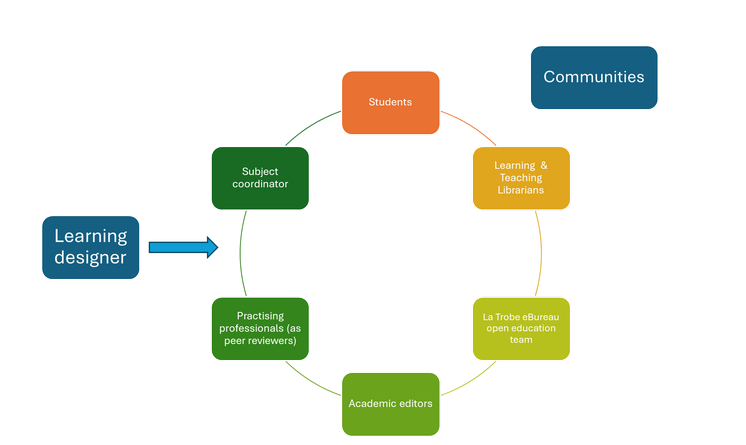

Working in a team across departments was rewarding and generated cross-disciplinary knowledge needed for Third Space projects like ours to flourish. For example, library staff (O’Hanlon) connected academic staff (Vanderbyl) with timely Council of Australian University Librarians (CAUL) OER Collective initiatives. Clare and Nikita enrolled together in the 2022 CAUL OER Professional Development program and fed their newly acquired practical skills back into the project. Similarly, academic staff highlighted grant and award opportunities from the History and Heritage sector. This informed a broader La Trobe eBureau paradigm shift to better align its open education program with academic reward and recognition systems.
Roles, responsibilities, and processes
As the original designers of HIS3MHI, historians Kat Ellinghaus and Emma Robertson joined Vanderbyl to form the academic editorial team, to curate and review student content for version 1. They were supported by Steven Chang and Sebastian Kainey, La Trobe eBureau staff with expertise in open pedagogy and OER development.
The first cohort of students in 2021 were self-nominating. Subsequently this has been refined with an Expression of Interest (EOI) process implemented by Nicole Gammie (Library Learning Service). Students continue to choose their own topics and utilise one of four formats: podcast, exhibition display, Wikipedia page, or illustrated essay.
In version 1, Library Learning Services staff provided scaffolded support and wrote a dedicated chapter in the OER to help students navigate open licensing, copyright, accessibility, and attribution. The University Copyright Advisor added expertise to the project by conducting final copyright compliance reviews. The open education team placed nominated assessment works into a web-ready format using an open book publishing tool (Pressbooks) and liaised with practising professionals outside the university to involve them as peer reviewers.
Work on version 2 began in 2023, adding the voices of professional historians for the first time. A call for new chapters was circulated to public history networks and specified certain criteria to ensure strong alignment between this new content and the subject’s weekly topics. This phase of the project also invited a second cycle of students-as-authors.
Project outcomes
The first version, Making Public Histories: Australian History Beyond the University, edited by Vanderbyl, Ellinghaus, and O’Hanlon, was published by the La Trobe eBureau in February 2023.
Developing this OER has met student need for resources that act as both inspiration and exemplars demonstrating HIS3MHI’s assessment requirements. Current and future students can see a research project path to follow from those who have gone before. These artefacts can be used to develop future students’ evaluative judgement, an increasingly valuable capability to make decisions about the quality of work of oneself and others, as outlined by Tai et al (2017).
This body of work expresses the voices of current and future historians. An important outcome from the chapters authored by professional historians is to strengthen the connection between history practiced in Australian universities and public history more broadly. The reflective pieces written by each student (appending their research projects) discuss how their historical research impacts the world outside the university. Students reap the benefits of this modelling as they develop their own identities as emerging practitioners.
A local outcome is that this project was spotlighted as part of La Trobe University’s Learning and Teaching Keynote on the theme of Students as Partners in October 2023. Reception outside La Trobe University has also been positive. Since publication of version 1 (October 2023), the textbook has been accessed over 4,000 times by 954 visitors. Version 2 was published in December 2024, accessible through the version 1 link.
Reflections on our project
Open practices cultivate professional identities
The core idea of this capstone subject has always been to encourage students to think about themselves as historians, instead of being a student writing about history. This includes inhabiting the role of the historian through different genres and media used to create their research project. The ethical questions students face in the process are captured in reflective writing accompanying each research project. Publishing these as part of the OER publicly demonstrates students’ metacognitive capabilities to engage in reflective practices and model this approach for future cohorts.
We ask students to think about what embodying the identity of ‘historian’ means. We encourage them to reflect on their positionality: who are they in relation to their topic? This emphasis is reflected in peer review feedback which indicated more could be done to put the text’s claims about diversity and inclusion into practice. We responded to this by publishing student biographies to better recognise their positionality as authors.
Open publishing enables questions like: what does it mean to write for an open audience, and not just for teaching staff? This is a weighty question for our students who chose topical areas like histories of previous attempts to set up a Voice to Parliament.
This example, by 2021 student Madeleine Gome, demonstrates the kind of reflections on both medium and accessibility, enabled by open publishing practices:
“…I knew there is a relative scarcity of academic writing on First Nations’ activism in the early 20th Century, and what has been written is often kept behind a paywall. I chose to write a Wikipedia-style article because this format is synonymous with succinct, easily understandable information. 1
Capstone research projects provide students an opportunity to put into practice the skills gathered across their whole degree, as they transition to the workplace. Real world authentic practices, such as engaging with copyright, peer review, and other aspects related to the rigour of academic publishing, introduces stakes for students while remaining safe. This OER is a publication students can show future employers as part of an e-portfolio demonstrating these accumulated professional capabilities. Table 2 demonstrates the diverse ways that OER development practices align with common graduate capabilities.
| OER development phase | Graduate capabilities | General capabilities |
| Writing author proposal | Communication;
Inquiry and analysis |
Ideation and project design; autonomous decision-making |
| Drafting manuscript | Discipline knowledge and skills;
Communication |
Writing and communication; project management |
| Checking copyright compliance | Personal and professional | Creative rights literacies; attribution & citation |
| Responding to peer review | Communication;
Personal and professional |
Evaluative judgement; shared collaboration; feedback literacy |
| Responding to copyedits | Personal and professional | Feedback literacy; evaluative judgement |
| Accessibility review | Communication | Universal design for learning; communicating to diverse communities |
| Publishing/promoting book | Personal and professional | Advocacy; stakeholder engagement |
| Assessing impact | Personal and professional | Evaluation, quantitative research, qualitative research |
Key challenges: students as co-creators
Publishing student work alongside that of professional historians, as we did in version 2, is an opportunity to break down hierarchies and demonstrate the potential of teaching approaches that recognise students as partners in learning and co-creators of meaning/knowledge (Fedoruk et al. 2021).
Aligning OER development models for student authors
This dynamic posed unusual dilemmas for the La Trobe eBureau, an open textbook program founded on the assumption that all authors are teaching academics. Given that its OER production infrastructure is designed with “conventional” academic-authored OERs in mind, this generated many questions like:
Are conventional academic peer review processes the right fit, given that academics and students aren’t formally peers?
It is a seemingly complex ‘can of worms’ question at first glance. However, engaging in reflective practices reminded us of our guiding principles of authentic learning, which led us to a surprisingly simple answer:
If the goal is to cultivate students’ identities as emerging scholars through authentic practice, then the most authentic approach is to not treat them differently than from academics.” (e.g., full peer review process)
Nevertheless, scaffolding is still important to develop students as open practitioners in the same way that OER PD supports academics. To support this, we created dedicated resources to explain the benefits and considerations involved in OER development to students.
Another significant challenge is that highly structured conventional OER production workflows are designed primarily for robust quality assurance and do not lend themselves to short turnarounds inside the bounds of a semester. This means a significant portion of student participation in OER development is extracurricular, with challenges of staying in contact with students after they have graduated or completed the subject. It also makes it difficult to holistically integrate the OER development model with assessment design, which is a key goal moving forward (see Figure 6 for our future directions).
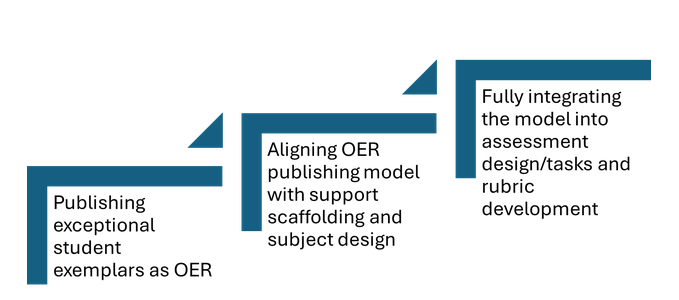
Furthermore, in terms of evaluating the OER, indicators of success are quite different from conventional open textbook publishing projects where the focus is on the number of adoptions, web engagement analytics, and student confidence in understanding content. Approaches for evaluating student-generated OER projects are more likely to incorporate assessment-related indicators such as increased student engagement with assessment and a higher standard of assessment work.
This has been a valuable lesson in the importance of matching open pedagogies with fit-for-purpose open technologies. Open Journal Systems is currently being investigated as an alternative option to create a “student journal” OER model that is light, fast, flexible, and gives subject coordinators direct control of the publishing system.
This is a brief summation of complex deliberations, but one of the main lessons here was to keep the spotlight on learning and teaching goals as a guiding principle. Other elements such as OER development and associated technologies should follow from this. It is easy to lose sight of this when thinking that OER production is the end goal, rather than a means to a greater end (namely, learning and teaching priorities).
In practice
Concluding recommendations for practitioners:
- Create collaborative Third Spaces for cultivating cross-disciplinary OEP teams that work across conventional professional-academic silos to foster mutual learning.
- Identify capstone subjects as spaces for piloting student-generated OER projects, as there is strong synergy with priorities such as authentic assessment, professional identity development, public communication, stakeholder engagement, research project artefacts, and evaluative judgement.
- For sustained OER projects over time, prioritise governance – such as establishing clear project roles, responsibilities, lines of communication, and expectations.
- Create significant time and space for planning how student-generated OER models might be integrated with assessment design.
- Provide scaffolding resources to develop students as open practitioners
- Continuously ask whether the relationship between your open pedagogies and open technologies is fit-for-purpose – of the two elements, learning and teaching goals should almost always take precedence as the guiding principle.
References
Fatayer, M., & Tualaulelei, E. (2023). Making the most of cognitive surplus: Descriptive case studies of student-generated open educational resources. Education Sciences, 13(10). 1011. https://doi.org/10.3390/educsci13101011
Neill, J. (2024). Collaborative authoring using wiki: An open education case study. International Journal for Students as Partners, 8(1), 224–232. https://doi.org/10.15173/ijsap.v8i1.5417
Tai, J., Ajjawi, R., Boud, D., Dawson, P., & Panadero, E. (2018). Developing evaluative judgement: Enabling students to make decisions about the quality of work. Higher Education, 76, 467-481.
Whitchurch, C. (2012). Reconstructing identities in higher education: The rise of “Third Space” professionals. Routledge.
Wiley, D., & Hilton III, J. L. (2018). Defining OER-enabled pedagogy. The International Review of Research in Open and Distributed Learning, 19(4). https://doi.org/10.19173/irrodl.v19i4.3601
Image descriptions
Figure 1: Front cover of the OER Making Public Histories: Australian History Beyond the University
Front cover of the OER Making Public Histories: Australian History Beyond the University. It features a green, stylistically pixelated filter over an image of a building with an arch.
Figure 2: Four sequential phases for developing Version 1 of Making Public Histories
Overview of four sequential phases for the development of the Making Public Histories ebook in descending order. Phase 1: research project assignment. Phase 2: Evaluation and selection. Phase 3: Revision and peer review. Phase 4: Reflection and launch of version 1.
Figure 3: Student-generated contributions to the OER Making Public Histories, using a diverse range of digital mediums
A collection of snapshots from student-generated contributions to the OER Making Public Histories, using a diverse range of digital mediums including podcasts and illustrated photo essays.
Figure 4: Students engage with diverse project stakeholders in a way that reflects authentic workplace and community practices that they face as emerging professionals. The blue boxes indicate aspirational stakeholders for future iterations of the project
A circular diagram illustrates how students engage with a diverse range of stakeholders such as librarians, peer reviewers, and academic editors. Three groups for future inclusion are learning designers, industry professionals, and broader communities beyond the university.
Figure 5: Adapted OER development model articulated by Fatayer and Tualaulelei (2023), where practising professionals are recruited from outside the university to support OER evaluation and, in turn, receive quality OER that support professional practice
A process diagram illustrating a model of OER development where practising professionals are recruited from outside the university to support OER evaluation and, in turn, receive quality OER that support professional practice.
Figure 6: Three-stage plan for closer integration of OER development into assessment design
A three-stage diagram showing models v1 and v2 as ascending steps progressing the integration of OER development with assessment design towards the highest peak: model v3.
Acknowledgement of peer reviewers
The authors gratefully acknowledge the following people who kindly lent their time and expertise to provide peer review of this chapter:
- James T. Neill, Assistant Professor, University of Canberra
How to cite and attribute this chapter
How to cite this chapter (referencing)
Vanderbyl, N., Ellinghaus, K., Robertson, E., Chang, S., O’Hanlon, C., & Gammie, N. (2024). Linking up Student and Academic Voices: Reuniting Higher Education and the Public Sphere Through OER. In Open Education Down UndOER: Australasian Case Studies. Council of Australian University Librarians. https://oercollective.caul.edu.au/openedaustralasia/chapter/linking-up-student-and-academic-voices
How to attribute this chapter (reusing or adapting)
If you plan on reproducing (copying) this chapter without changes, please use the following attribution statement:
Linking up Student and Academic Voices: Reuniting Higher Education and the Public Sphere Through OER by Nikita Vanderbyl, Katherine Ellinghaus, Emma Robertson, Steven Chang, Clare O’Hanlon & Nicole Gammie, is licensed under a Creative Commons Attribution 4.0 International licence.
If you plan on adapting this chapter, please use the following attribution statement:
*Title of your adaptation* is adapted from Linking up Student and Academic Voices: Reuniting Higher Education and the Public Sphere Through OER by Nikita Vanderbyl, Katherine Ellinghaus, Emma Robertson, Steven Chang, Clare O’Hanlon & Nicole Gammie, used under a Creative Commons Attribution 4.0 International licence.

